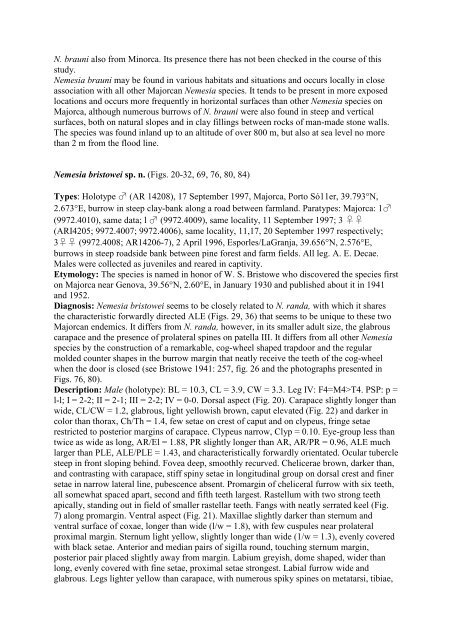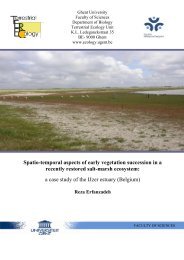PhD Arthur Decae 2010 - Ghent Ecology - Universiteit Gent
PhD Arthur Decae 2010 - Ghent Ecology - Universiteit Gent
PhD Arthur Decae 2010 - Ghent Ecology - Universiteit Gent
You also want an ePaper? Increase the reach of your titles
YUMPU automatically turns print PDFs into web optimized ePapers that Google loves.
N. brauni also from Minorca. Its presence there has not been checked in the course of this<br />
study.<br />
Nemesia brauni may be found in various habitats and situations and occurs locally in close<br />
association with all other Majorcan Nemesia species. It tends to be present in more exposed<br />
locations and occurs more frequently in horizontal surfaces than other Nemesia species on<br />
Majorca, although numerous burrows of N. brauni were also found in steep and vertical<br />
surfaces, both on natural slopes and in clay fillings between rocks of man-made stone walls.<br />
The species was found inland up to an altitude of over 800 m, but also at sea level no more<br />
than 2 m from the flood line.<br />
Nemesia bristowei sp. n. (Figs. 20-32, 69, 76, 80, 84)<br />
Types: Holotype ♂ (AR 14208), 17 September 1997, Majorca, Porto Só11er, 39.793°N,<br />
2.673°E, burrow in steep clay-bank along a road between farmland. Paratypes: Majorca: 1♂<br />
(9972.4010), same data; l ♂ (9972.4009), same locality, 11 September 1997; 3 ♀♀<br />
(ARI4205; 9972.4007; 9972.4006), same locality, 11,17, 20 September 1997 respectively;<br />
3♀♀ (9972.4008; AR14206-7), 2 April 1996, Esporles/LaGranja, 39.656°N, 2.576°E,<br />
burrows in steep roadside bank between pine forest and farm fields. All leg. A. E. <strong>Decae</strong>.<br />
Males were collected as juveniles and reared in captivity.<br />
Etymology: The species is named in honor of W. S. Bristowe who discovered the species first<br />
on Majorca near Genova, 39.56°N, 2.60°E, in January 1930 and published about it in 1941<br />
and 1952.<br />
Diagnosis: Nemesia bristowei seems to be closely related to N. randa, with which it shares<br />
the characteristic forwardly directed ALE (Figs. 29, 36) that seems to be unique to these two<br />
Majorcan endemics. It differs from N. randa, however, in its smaller adult size, the glabrous<br />
carapace and the presence of prolateral spines on patella III. It differs from all other Nemesia<br />
species by the construction of a remarkable, cog-wheel shaped trapdoor and the regular<br />
molded counter shapes in the burrow margin that neatly receive the teeth of the cog-wheel<br />
when the door is closed (see Bristowe 1941: 257, fig. 26 and the photographs presented in<br />
Figs. 76, 80).<br />
Description: Male (holotype): BL = 10.3, CL = 3.9, CW = 3.3. Leg IV: F4=M4>T4. PSP: p =<br />
l-l; I = 2-2; II = 2-1; III = 2-2; IV = 0-0. Dorsal aspect (Fig. 20). Carapace slightly longer than<br />
wide, CL/CW = 1.2, glabrous, light yellowish brown, caput elevated (Fig. 22) and darker in<br />
color than thorax, Ch/Th = 1.4, few setae on crest of caput and on clypeus, fringe setae<br />
restricted to posterior margins of carapace. Clypeus narrow, Clyp = 0.10. Eye-group less than<br />
twice as wide as long, AR/El = 1.88, PR slightly longer than AR, AR/PR = 0.96, ALE much<br />
larger than PLE, ALE/PLE = 1.43, and characteristically forwardly orientated. Ocular tubercle<br />
steep in front sloping behind. Fovea deep, smoothly recurved. Chelicerae brown, darker than,<br />
and contrasting with carapace, stiff spiny setae in longitudinal group on dorsal crest and finer<br />
setae in narrow lateral line, pubescence absent. Promargin of cheliceral furrow with six teeth,<br />
all somewhat spaced apart, second and fifth teeth largest. Rastellum with two strong teeth<br />
apically, standing out in field of smaller rastellar teeth. Fangs with neatly serrated keel (Fig.<br />
7) along promargin. Ventral aspect (Fig. 21). Maxillae slightly darker than sternum and<br />
ventral surface of coxae, longer than wide (l/w = 1.8), with few cuspules near prolateral<br />
proximal margin. Sternum light yellow, slightly longer than wide (1/w = 1.3), evenly covered<br />
with black setae. Anterior and median pairs of sigilla round, touching sternum margin,<br />
posterior pair placed slightly away from margin. Labium greyish, dome shaped, wider than<br />
long, evenly covered with fine setae, proximal setae strongest. Labial furrow wide and<br />
glabrous. Legs lighter yellow than carapace, with numerous spiky spines on metatarsi, tibiae,










